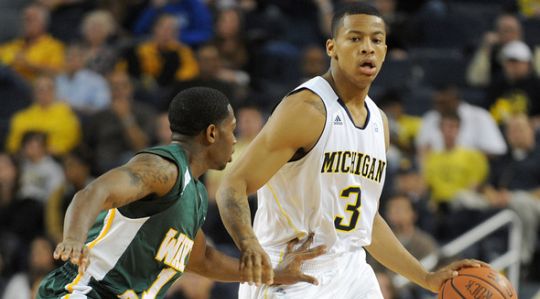Four Stat Lines That Will Determine Michigan’s Chances of Advancing Past Syracuse
Posted by Deepak Jayanti on April 5th, 2013Deepak is a writer for the Big Ten microsite of RTC. Follow him on Twitter for more about B1G hoops at @dee_b1g.
As we approach a very intriguing Final Four match-up between Michigan and Syracuse, the game has been analyzed through many angles using statistics like points per possession, effective field goal percentage or turnovers per game. The result of this game will basically be determined by one question: Can the Wolverines break the Orange’s 2-3 zone defense? The following are four key stat lines that could determine Michigan’s rhythm on the offensive end against the mighty zone and if it can get past Syracuse to play either Louisville or Wichita State in the National Championship game on Monday night.

It is a bad sign for the Michigan offense when Trey Burke shoots more than 20 times in a game. (annarbor.com)
- Trey Burke’s total number of shot attempts: 17.5. Burke was not rewarded the AP Player of the Year because he takes 20 shots per game and averages over 20 PPG, but rather because he makes plays by controlling the tempo and involving his teammates. When he shoots over 20 times per game, the Wolverines suffer because most of those shots come from beyond the arc which indicates that he wasn’t able to get into the paint to involve his teammates for easy looks. It could be a bad sign if Burke takes more than 17 shots on Saturday because reversing the ball to force the zone to move and getting past the initial layer of defense will be key to a Michigan victory.
- Total number of combined layups or dunks by Glenn Robinson and Tim Hardaway Jr: 5.5. Our friends in Vegas probably don’t have a specific line set for this statistic but regardless of the proposition, getting easy points from layups and dunks will be essential for a young Wolverines squad that could get frustrated if it has to beat the Orange from beyond the arc. Assuming that Michigan scores about 60 points during the game, it would be a huge boost to the young players’ confidence against the zone if 20% of their points (~12 points) come from simple backdoor cuts or transition layups from these guys. Going over this line will also indicate that Burke or Nik Stauskas were able to drive to the basket on a handful of possessions which will prevent them from getting into any sort of a rut and settling for flat-footed jumpers.
- Total number of combined jumpers from the high post by Mitch McGary or Glenn Robinson: 3.5. Analyzing the keys to breaking the zone has been a consistent topic of discussion in the hoops world over the past few days and one of the most important offensive positions is the high post. John Beilein will certainly start with McGary there to receive a pass from the wings but the best way to force the defense to collapse is to drain an early jumper or two from that position. Even though McGary has been on fire in this tournament, his jumper is still a work in progress, so it is likely that Rakeem Christmas or Baye Keita will give McGary space unless he makes them pay for it. Because of his much smoother jumper, Robinson may see some minutes in the high post during certain possessions but that would most likely mean that McGary will be limited at the same time. Beating the zone by trying to drive from the high post could be dangerous (ask Cody Zeller) because McGary could pick up an offensive foul very easily and his presence on the floor has become quite crucial to the success of the Wolverines.
- Total number of blocks by Christmas and Keita in the paint: 2.5. One way to neutralize the 2-3 zone is to force the Orange to earn every one of their buckets and one of the Wolverines’ primary goals should be to keep Syracuse from scoring in transition. Christmas and Keita average a combined three blocks per game and most of their blocks are near the basket which allows the recovery to make the outlet pass to Michael Carter-Williams pushing the break. Except for Burke, Michigan’s wings have sufficient length to avoid being stuffed by the Orange in the paint so they should have success keeping the turnovers in the paint to a minimum. If they can’t, the game could get out of hand very quickly because Syracuse can score in bunches in transition. Besides the transition points, a strong block by the lengthy Syracuse forwards can also serve a bold statement against the Michigan wings, who may decide to settle for long jumpers if they become intimidated by their length. On the flip side, going for a big block could also result in a foul which could serve as a confidence booster to Michigan by giving their scorers some free points at the charity stripe.











































